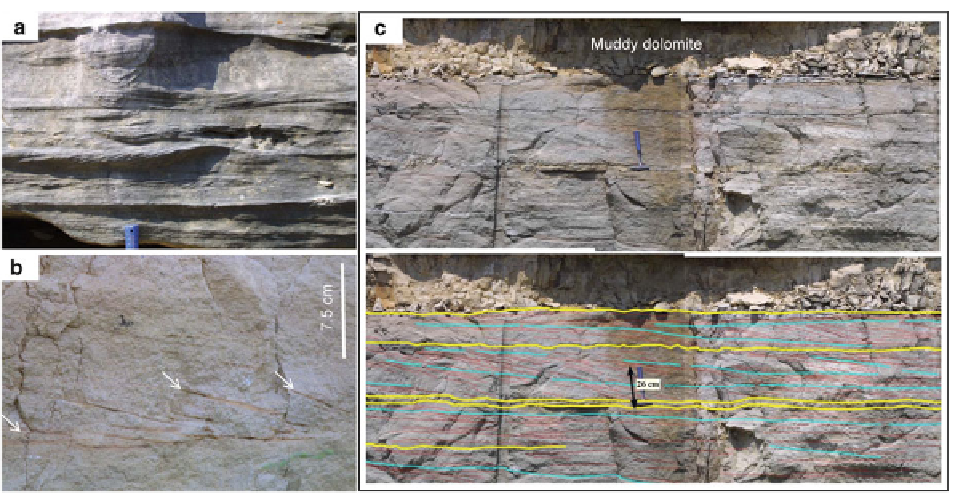Geology Reference
In-Depth Information
Fig. 20.22
Representative outcrop photos of a non-oolitic
tidal sand unit, the Mississippian Salem Limestone, near St.
Louis, Missouri. (
a
) Current ripples in a foraminiferal grain-
stone. Hammer handle in bottom center for scale. (
b
) Muddy
bottomsets on small trough cross-bed set. Some muddy layers
are highlighted by
arrows
. (
c
) Paired uninterpreted (
upper
) and
annotated (
lower
) photos of a cross-bedded interval overlain
by a dolomitic muddy unit. The cross-bedded unit includes a
set of laminae (some highlighted by
red lines
) stacked into
bundles (
blue lines
), some of which may include muddy toe-
sets. Sets of bundles are separated by thin (<4 cm) muddy lay-
ers (
yellow lines
)
Bathurst RGC (1975) Carbonate sediments and their diagenesis,
vol 12, Developments in sedimentology. Elsevier, Amsterdam,
658 pp
Beach DK, Ginsburg RN (1980) Facies succession of Pliocene-
Pleistocene carbonates, northwestern Great Bahama Bank.
Am Assoc Petrol Geol Bull 64:1634-1642
Braithwaite CJR (1973) Settling behaviour related to sieve anal-
ysis of skeletal sands. Sedimentology 20:251-263
Brown MA, Archer AA, Kvale EP (1990) Neap-spring tidal
cyclicity in laminated carbonate channel-fi ll deposits and its
implications; Salem Limestone (Mississippian), south-central
Indiana, U.S.A. J Sediment Res 60:152-159
Budd DA (1984) Freshwater diagenesis of Holocene ooid sands,
Schooner Cays, Bahamas. Unpublished Ph.D. dissertation,
University of Texas, Austin, 491 p
Carney C, Boardman MR (1993) Trends in sedimentary micro-
fabrics of ooid tidal channels and deltas. In: Rezak R, Lavoie
DL (eds) Frontiers in sedimentary geology: carbonate micro-
fabrics. Springer, New York, pp 29-39
Carr DD (1973) Geometry and origin of oolite bodies in the Ste.
Genevieve Limestone (Mississippian) in the Illinois basin.
Indiana Geol Surv Bulletin 48, 81 p
Caston VND (1972) Linear sand banks in the southern North
Sea. Sedimentology 18:63-78
Cavallo LJ, Smosna R (1997) Predicting porosity distribution
within oolitic bars in J.A. Kupecz, J. Gluyas, and S. Block
(eds.), reservoir quality prediction in sandstones and carbon-
ates. Am Assoc Petrol Geol Mem 69:211-229
and the vigorous tides impacting these platforms.
Many ancient systems include what appear to be
tidal sands but are not oolitic. How do the sedimen-
tology, geomorphology, and diagenetic character of
these systems differ from their oolitic relatives?
Clearly, many important and interesting questions
regarding tidal sand shoals and their geologic record
await future study.
References
Agassiz A (1896) The elevated reef of Florida. Bull Mus Comp
Zool 28:1-62
Ashley GM (1990) Classifi cation of large-scale sub-aqueous
bedforms: a new look at an old problem. J Sediment Petrol
60:160-172
Aurell M, McNeill DF, Guyomard T, Kindler P (1995) Pleistocene
shallowing-upward sequences in New Providence, Bahamas:
signature of high-frequency sea-level fl uctuations in shallow
carbonate platforms. J Sediment Res B65:170-182
Ball MM (1967) Carbonate sand bodies of Florida and the
Bahamas. J Sediment Petrol 37:556-591
Bathurst RGC (1967) Oolitic fi lms on low energy carbonate
sand grains, Bimini Lagoon, Bahamas. Mar Geol 5:89-109.

